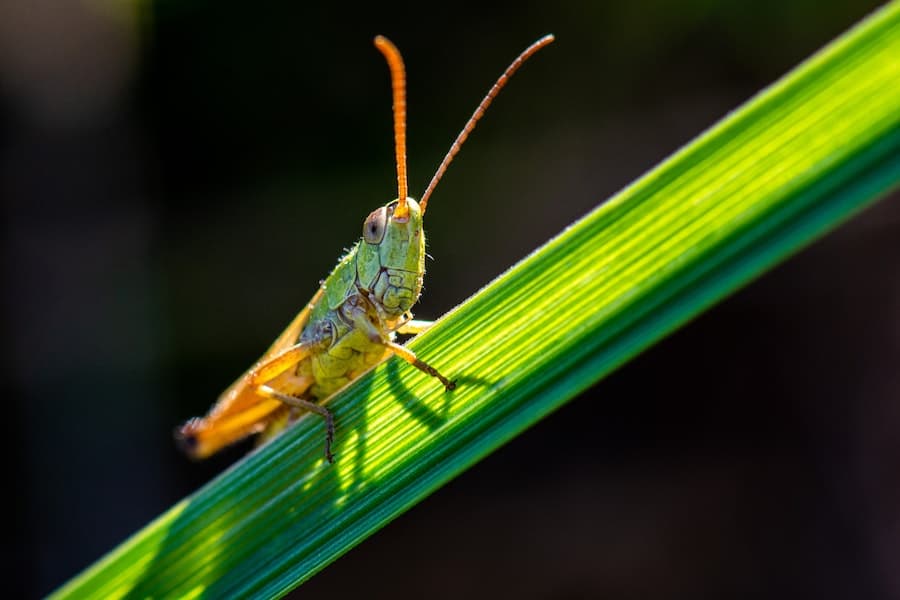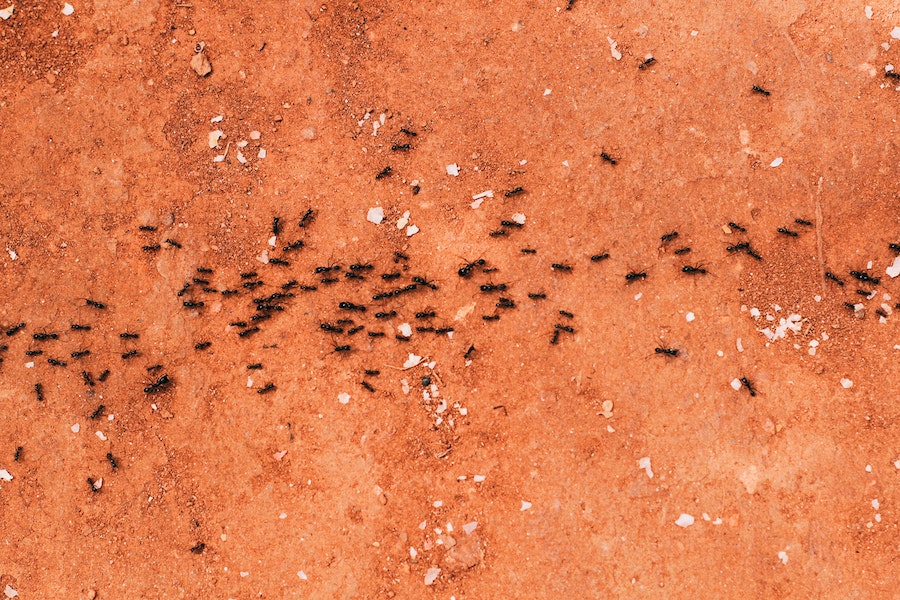Grasshoppers, fascinating insects known for their distinct chirping sounds and remarkable jumping abilities, have long piqued the curiosity of scientists and nature enthusiasts alike. Among the many questions surrounding these creatures, one of the most commonly asked is: Do grasshoppers eat grass? Understanding the feeding habits of grasshoppers is crucial for unraveling their ecological role and impact on the environment. In this article, we will explore the intricate world of grasshopper feeding, examining their diet preferences, feeding mechanisms, and the broader implications of their herbivorous habits in the natural world.
Do Grasshoppers Eat Grass?
Yes, grasshoppers do eat grass. They are primarily herbivorous insects that feed on various types of plants, with grass being one of their main food sources. Their chewing mouthparts allow them to consume leaves and other plant materials, making them important players in the ecosystem as herbivores.
Differences In Diet Among Grasshopper Species
Dietary preferences can vary significantly among different grasshopper species, reflecting their adaptability to various environments and the availability of food sources. While most grasshoppers are herbivorous, the specific plants they consume can vary depending on factors such as geographic location, climate, and habitat.
Some grasshopper species are specialized feeders, showing a strong preference for specific types of grasses or plants. For instance, certain grasshopper species may exclusively feed on grasses found in arid regions, as they have evolved to thrive in such harsh conditions. On the other hand, some species may show a broader diet, consuming a range of plant species, including herbs, shrubs, and even agricultural crops.
The differences in diet among grasshopper species can also be influenced by their life stages. For example, young nymphs might have different feeding preferences compared to adult grasshoppers. Nymphs may consume tender, succulent plant parts, while adults with more robust mouthparts may consume tougher vegetation.
Additionally, competition with other herbivorous insects and predators in their habitat can also affect the diet of grasshopper species. When certain plant resources are scarce, grasshoppers may adjust their feeding habits to consume alternative plant species that are more abundant in their environment.
Grasshoppers And Plant Consumption
Grasshoppers play a crucial role in plant consumption within ecosystems, as they are primarily herbivorous insects that feed on various types of plants. Their feeding habits can have significant impacts on vegetation and plant populations.
- Grass as a Staple Food Source: Grasshoppers are well-known for their consumption of grass, which serves as a staple food source for many species. They have specialized chewing mouthparts that allow them to consume grass leaves and stems efficiently. Grasshoppers can significantly affect the growth and health of grasslands, and their population dynamics can influence the balance between grasses and other plant species within these habitats.
- Preference for Certain Grass Species: Different grasshopper species may exhibit preferences for specific grass species based on factors such as taste, nutritional content, and the presence of chemical compounds. Some grasshoppers might prefer to feed on certain grasses due to their higher protein or sugar content, which can impact the growth and survival of those plant species.
- Grasshopper Feeding on Other Plant Types: While grasses are their primary food source, grasshoppers are not limited to consuming only grasses. They can also feed on a wide range of plants, including various herbs, shrubs, and agricultural crops. In certain circumstances, when grasses are scarce, they can shift their diet to other available plant materials, leading to potential ecological consequences and implications for crop damage in agricultural settings.
- Impact on Vegetation and Ecosystems: Grasshoppers’ feeding behavior can influence the structure and composition of plant communities within their habitats. High grasshopper populations can lead to overgrazing and defoliation of plants, affecting their growth and reproduction. Conversely, their presence can also promote nutrient cycling through the recycling of plant material, contributing to ecosystem dynamics.
- Ecological Balance: Despite their potential impact on vegetation, grasshoppers are essential components of ecological balance. As herbivores, they help regulate plant populations, preventing overgrowth and maintaining biodiversity within ecosystems. They also serve as a vital food source for various predators, such as birds, mammals, and other insects, contributing to the overall balance of the food web.
Controlling Grasshopper Population Through Feeding
Controlling grasshopper populations through feeding is a vital aspect of pest management and agricultural practices. Various strategies can be employed to regulate grasshopper populations and mitigate potential crop damage caused by these voracious herbivores.
- Natural Predators and Biological Control: Encouraging the presence of natural predators that feed on grasshoppers can help control their populations. Predatory insects, birds, and small mammals, such as spiders, beetles, birds of prey, and rodents, play a crucial role in keeping grasshopper numbers in check. Implementing practices that support diverse habitats for these predators can be an effective way to limit grasshopper populations without resorting to chemical control methods.
- Parasites and Diseases: Certain parasites and diseases specifically target grasshoppers, leading to population reductions. Naturally occurring pathogens or biocontrol agents can be introduced into grasshopper habitats to help manage their numbers. However, careful consideration must be given to the potential impact on non-target species and the overall ecosystem balance.
- Crop Rotation and Habitat Management: Implementing crop rotation practices can disrupt grasshopper feeding patterns. By altering the type and location of crops, farmers can discourage grasshoppers from concentrating in specific areas. Additionally, habitat management, such as the creation of buffer zones or refuge areas for natural predators, can help maintain a balanced ecosystem and control grasshopper populations.
- Pheromone-Based Traps and Attractants: Pheromone-based traps and attractants can be used to lure grasshoppers away from crops or into specific areas where they can be monitored and controlled more effectively. These traps can disrupt mating and feeding behaviors, providing an alternative to chemical pesticides for grasshopper management.
- Integrated Pest Management (IPM) Techniques: Adopting Integrated Pest Management (IPM) techniques is a holistic approach that combines multiple strategies to manage grasshopper populations sustainably. IPM focuses on monitoring grasshopper populations, identifying thresholds for intervention, and selecting the most appropriate and least harmful control methods based on the specific situation.
Ecological Implications Of Grasshopper Feeding Habits
Grasshopper feeding habits have significant ecological implications, as they play a crucial role in shaping ecosystems and influencing the dynamics of plant communities and animal populations. Understanding these implications is essential for managing grasshopper populations, conserving biodiversity, and maintaining ecological balance.
- Plant Population Dynamics: Grasshoppers are herbivores that consume vegetation, particularly grasses and other plants. Their feeding behavior can have a direct impact on plant populations, affecting the growth, reproduction, and distribution of various plant species. High grasshopper populations can lead to overgrazing and defoliation of plants, which may alter the composition of plant communities and disrupt the balance between different plant species.
- Ecosystem Structure and Function: The abundance of grasshoppers can influence the structure and function of ecosystems. Their feeding can affect the vegetation cover, nutrient cycling, and energy flow within the ecosystem. For instance, excessive grazing by grasshoppers can reduce plant cover, leading to changes in soil properties and affecting the availability of resources for other organisms in the ecosystem.
- Plant-Grasshopper Interactions: Grasshopper feeding can trigger plant defenses and chemical responses. As a result, plants may produce secondary metabolites or toxins to deter grasshopper herbivory. This interaction between plants and grasshoppers can lead to co-evolutionary processes, where plants develop defensive strategies, and grasshoppers, in turn, adapt to overcome these defenses.
- Impact on Other Organisms: Grasshoppers serve as an essential food source for a variety of predators, including birds, mammals, reptiles, and insects. Changes in grasshopper populations can, therefore, have cascading effects on predator-prey dynamics within the food web. A decline in grasshopper populations could negatively impact predator species, leading to a shift in community structure and potential disruptions to the broader ecosystem.
Conclusion
In conclusion, understanding the feeding habits of grasshoppers is essential for comprehending their ecological impact and role within ecosystems. As herbivorous insects, grasshoppers play a vital role in regulating plant populations, shaping plant communities, and serving as a crucial food source for various predators. The implications of their feeding habits extend to biodiversity, ecosystem structure, and sustainable agriculture. Balancing the management of grasshopper populations while preserving ecological integrity requires a holistic approach that considers the intricate interplay between these fascinating insects and their environment.
FAQ’s
Q: Do Grasshoppers Eat Only Grass?
While grass is a primary food source for many grasshopper species, they are not limited to consuming grass alone. Grasshoppers are generalist herbivores and can feed on a wide range of plants, including herbs, shrubs, and agricultural crops.
Q: Are Grasshoppers Harmful To Crops?
Yes, grasshoppers can be harmful to crops when their populations reach damaging levels. They have strong chewing mouthparts that allow them to consume large amounts of vegetation, leading to defoliation and reduced crop yields.
Q: Do Grasshoppers Have Any Natural Predators?
Yes, grasshoppers have several natural predators, including birds, mammals, reptiles, and other insects. These predators play a vital role in controlling grasshopper populations and maintaining ecological balance.
Q: Can Grasshopper Feeding Trigger Plant Defenses?
Yes, grasshopper feeding can trigger plant defenses. When grasshoppers consume plant tissue, the plants may produce chemicals and secondary metabolites as a defensive response to deter further herbivory.
Q: How Do Farmers Control Grasshopper Populations In Agriculture?
Farmers use various strategies to control grasshopper populations in agriculture. These include implementing integrated pest management (IPM) techniques, crop rotation, biological control through natural predators, and selective use of pesticides as a last resort when other methods are not effective.








